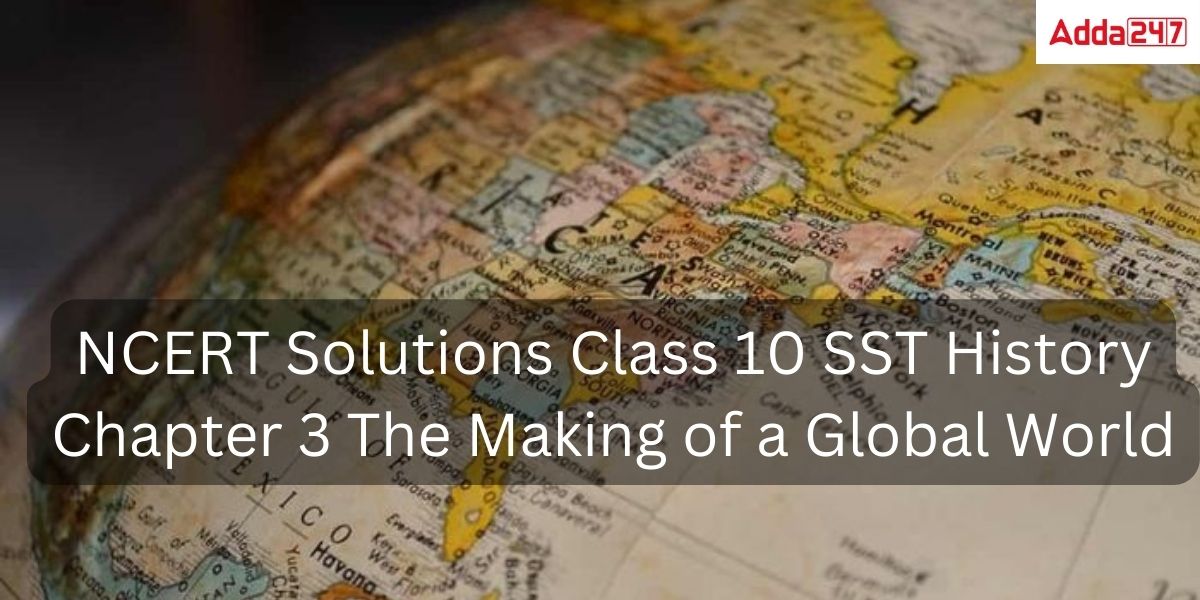NCERT Solutions Class 10 SST History Chapter 3 The Making of Global World notes are given in this article. NCERT Solutions Class 10 is the best resource for obtaining a good score in the class 10 board Examination. Here are Adda247 Expert faculty team prepared NCERT Solutions Class 10 SST History Chapter 3 The Making of Global World exercises of that chapter for a better grasp of the topics.
These NCERT Solutions answer all questions in an easy and simple manner. These solutions will help you understand the concepts covered in the chapter completely. By writing these answers in the exam students will undoubtedly be able to achieve high scores. Keep learning with Adda247.
NCERT Solutions Class 10 SST History Chapter 3 The Making of a Global World Pdf Download
NCERT Solutions Class 10 SST History Chapter 3 The Making of a Global World pdf is given in pdf format so students can easily download it for future use. Click here to download NCERT Solutions Class 10 SST History Chapter 3 The Making of a Global World
NCERT Solutions Class 10 SST History Chapter 3 The Making of a Global World Video Explanation
NCERT Solutions Class 10 SST History Chapter 3 The Making of a Global World Summary
Class 10 SST History Chapter 3 The Making of a Global World introduces the creation of the world, which has a long history of trade, and migration. Before going to the exercise let’s get a quick review of the topics and subtopics in the NCERT Solutions Class 10 SST History Chapter 3 The Making of a Global World.
1.The Pre-modern World
1.1 Silk Routes Link the World
1.2 Food Travels: Spaghetti and Potato
1.3 Conquest, Disease and Trade
2. The Nineteenth Century (1815 – 1914)
2.1 A World Economy Takes Shape
2.2 Role of Technology
2.3 Late nineteenth-century Colonialism
2.4 Rinderpest, or the Cattle Plague
2.4 Indentured Labour Migration from India
2.5 Indian Entrepreneurs Abroad
2.6 Indian Trade, Colonialism and the Global System
3. The Inter-war Economy
3.1 Wartime Transformations
3.2 Post-war Recovery
3.3 Rise of Mass Production and Consumption
3.4 The Great Depression
3.5 India and the Great Depression
4. Rebuilding a World Economy: The Postwar Era
4.1 Post-war Settlement and Bretton Woods Institution
4.2 The Early Post-war Years
4.3 Decolonisation and independence
4.4 End of Bretton Woods and the Beginning of Globalisation
NCERT Solutions Class 10 SST History Chapter 3 The Making of a Global World Questions with Answer
- The silk routes are an excellent example of cross-cultural trade and global connectivity.
Historians have identified several silk routes, both overland and by sea, that connect Asia to Europe and northern Africa.
These trade routes carried Chinese pottery, textiles, and spices from India and Southeast Asia. In exchange, precious metals such as gold and silver were transported from Europe to Asia.’ - Many of our foodstuffs, such as potatoes, soya, groundnuts, maize, tomatoes, and chilies, originated with America’s first inhabitants, the American Indians. America was widely available in food and minerals. After Christopher Columbus accidentally discovered America, common foods such as potatoes, tomatoes, chilies, soya, maize, groundnuts, and so on made their way to Europe and then Asia.
- The British government’s decision to abolish the Corn Laws resulted in an influx of cheaper crops from America and Australia. Agriculture in the United Kingdom was unable to compete with imports. Many English farmers abandoned their farms and moved to towns and cities. Some went abroad. This indirectly resulted in global agriculture and rapid urbanization, both of which are required for industrial growth.
- Rinderpest (a rapidly spreading cattle plague disease) arrived in Africa in the late 1880s. It had a horrific impact on people’s livelihoods and the local economy. It killed roughly 90% of the cattle. It was spread by infected cattle imported from British Asia to feed Italian troops invading Eritrea in East Africa. Taking advantage of this situation, colonizing nations conquered and subdued Africa by monopolizing scarce cattle resources in order to force Africans into the labour market. Due to the loss of their livelihood due to the effects of Rinderpest, Africans were forced to work for a wage.
- The death of men of working age in Europe as a result of the World War reduced the able-bodied workforce in Europe; as a result, women stepped in to do jobs that previously only men were expected to do. It increased women’s roles, resulting in a demand for equal status in society. It enhanced the feminist movement.
- In the nineteenth century, colonial India had become an exporter of agricultural goods and an importer of manufactured goods. As international prices fell, so did Indian prices. Between 1928 and 1934, wheat prices in India fell by half. The Great Depression resulted in a loss of revenue for Indian farmers as export prices fell dramatically. As the government did not reduce taxes, peasant indebtedness increased throughout India.
- Wages in Asian countries were relatively low. As a result, they became attractive investment destinations for foreign MNCs. Because of the relocation of manufacturing to Asian countries, Asian economies expanded significantly and employment increased. It boosted global trade and increased capital inflows into Asian countries
Answer:
- A faster and safer deliveryof the foods to the markets was made possible by improved transportation infrastructure. Food could be transported inexpensively and rapidly from distant farms to final markets due to faster rails, lighter carriages, and larger ships.
- Perishable items could be shipped across large distances aboard refrigerated ships. Additionally, frozen meat from America and Australia was shipped to Europe. This brought down European meat prices and lowered transportation expenses.
5. What is meant by the Bretton Woods Agreement?
Answer: The Bretton Woods Agreement established a system for establishing a fixed currency exchange rate using gold as the universal standard. The Bretton Woods Agreement was signed in July 1944 at Bretton Woods in New Hampshire, USA, by the world powers. The agreement, which involved representatives from 44 countries, resulted in the establishment of the International Monetary Fund (IMF) and the World Bank.
According to the agreement, currencies would be pegged Western industrial powers were given decision-making authority. The United States was granted veto power over key IMF and World Bank decisions. Fixed exchange rates were the foundation of the Bretton Woods system. The Bretton Woods system ushered in an era of unprecedented trade and income growth for the Western industrial nations and Japan.
1)Trade Flow
2)Human Capital Flows
3)Capital Flows
- Bank failure: The withdrawal of US loans had a negative impact on the money investment systems. In Europe, it resulted in the failure of the majority of the major banks. Some of the banks were listed on the stock exchange when the market crashed in 1929. It caused investors and depositors to panic. They stopped investing and depositing.
- Overproduction in agriculture was a major issue. As a result, agricultural prices have dropped. Agricultural income fell as prices fell. This increased the market’s volume of goods. Due to a lack of buyers, farm produce began to rot.
- In the 1920s, economic growth in the United States created a cycle of enhanced employment and income which results in increased consumption and demand. More investment and employment created speculation tendencies, which led to the Great Depression of 1929 until the mid-1930s.
Answer: A new International Economic Order was demanded by the G-77 group of developing nations NIEO). They described the NIEO as a system that would offer them full sovereignty over their natural resources, more equitable raw material prices, and better access for their produced commodities to markets in the industrialized nations.











 AILET Result 2026 Release Date, How to D...
AILET Result 2026 Release Date, How to D...
 CLAT Result 2026 Out, Download Scorecard...
CLAT Result 2026 Out, Download Scorecard...
 CLAT Topper List 2026 Released with Rank...
CLAT Topper List 2026 Released with Rank...














